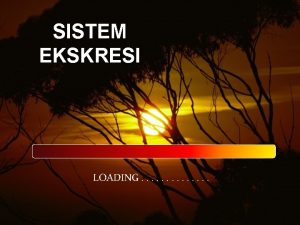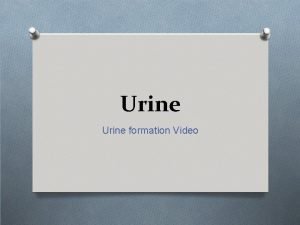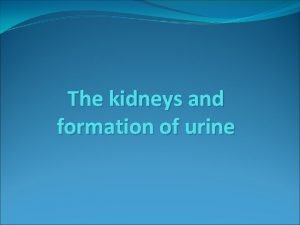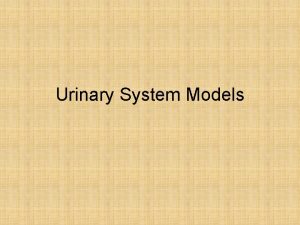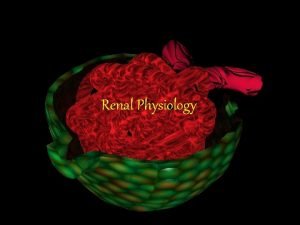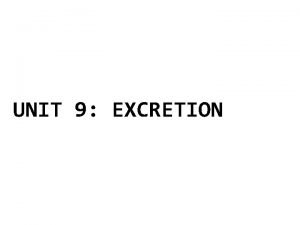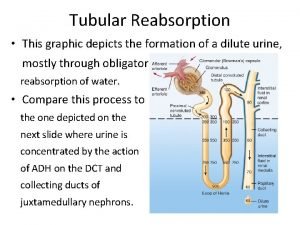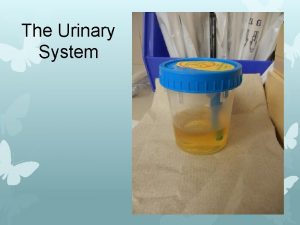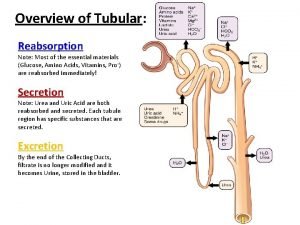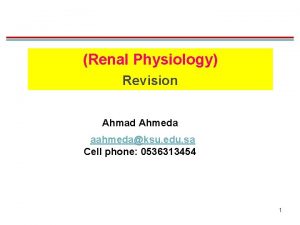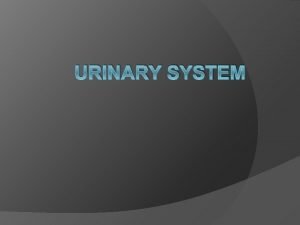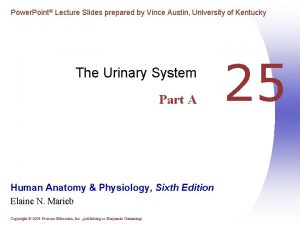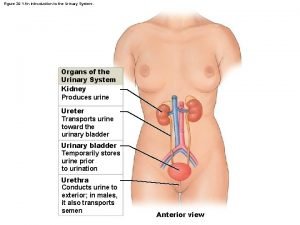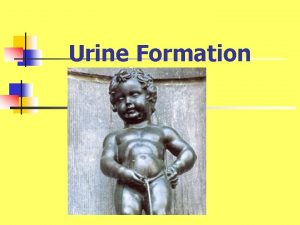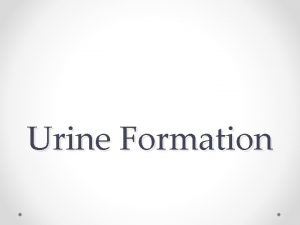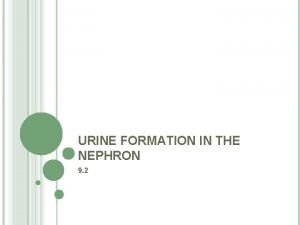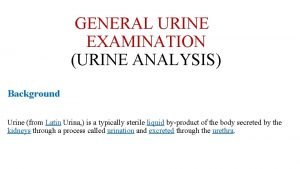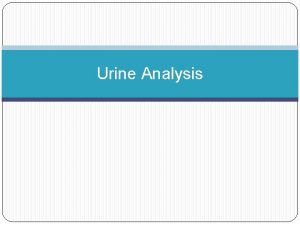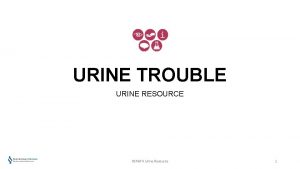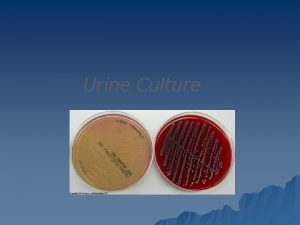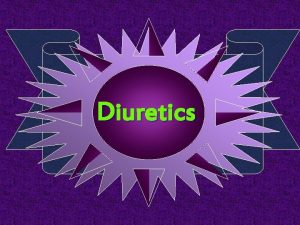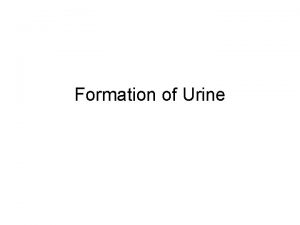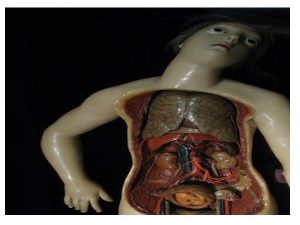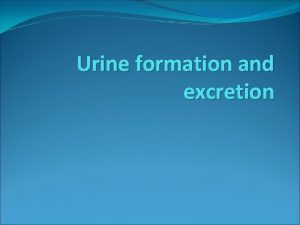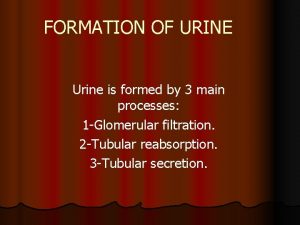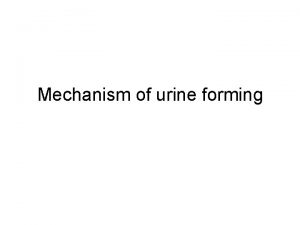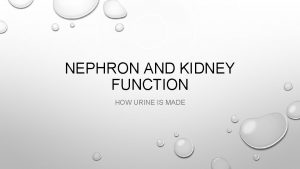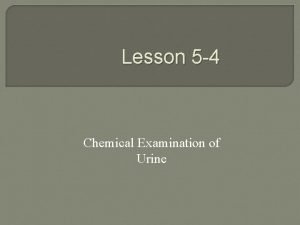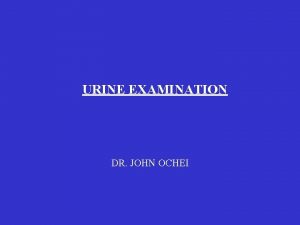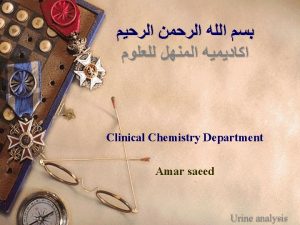Urine Formation in the Nephron There are 4






















- Slides: 22

Urine Formation in the Nephron There are 4 processes that are crucial to the formation of urine

Glomerular filtration moves water & solutes, except proteins, from blood plasma into the nephron (filtrate); 2 factors affect this. . . the permeability of the capillaries (many, many pores) and blood pressure (force of blood affects filtration)

Tubular reabsorption removes useful substances such as sodium from the filtrate & returns them into the blood for the reuse by the body systems Tubular Reabsorption (in depth); ~65% of filtrate that passes through proximal tubule is reabsorbed & returned to body. Requires both active (requires ATP) & passive transport

Tubular secretion moves additional wastes & excess substances from the blood into the filtrate active reabsorption of Na+ ions (from filtrate to capillaries) and passive reabsorption of Cl- ions (& others); K+ ions are actively secreted into distal tubule from bloodstream to capillaries; H+ ions actively secreted to maintain proper p. H

Water reabsorption removes water from the filtrate & returns it to the blood from re-use by body systems

The Loop of Henle reabsorbs water & ions from Glomerular filtrate; as loop enters deeper portion of medulla, higher salt content. Water diffuses from filtrate to capillaries by osmosis

Ascending Loop; less permeable than before; Na+ ions diffuse from filtrate & pass into nearby blood vessels (this makes filtrate less concentrated)

Reabsorption from Collecting Duct Filtrate entering collecting duct still contain a lot of water; collecting duct extends into medulla where concentration of ions is higher as a result of active transport of ions from ascending limb

Reabsorption from Collecting Duct Causes water to passively follow (osmosis); this causes the filtrate to become up to 4 x as concentrated (now is called urine)

Structure & Function Glomerulus Filtration Glomerular blood pressure forces some of the water & dissolved substances from the blood plasma through pores of the Glomerular walls

Structure & Functure Bowman’s Capsule Filtration Recieve’s filtrate from glomerulus

Structure & Function Proximal Tubule Reabsorption Active reabsorption of all nutrients, including glucose & amino acids Active reabsorption of +ve’lycharged ions (Na+, K+, Ca 2+) Passive reabsorption of water by osmosis Passive reabsorption of –ve’ly charged ions like Cl- & bicarbonate ions Secretion Active secretion of hydrogen ions

Structure & Function Descending of Henle Loop Reabsorption Passive reabsorption of water by osmosis

Structure & Function Ascending of Henle Loop Reabsorption Active reabsorption of sodium ions Passive reabsorption of Cl& K+ ions

Structure & Function Distal tube Reabsorption Active reabsorption of Na+ ions Passive reabsorption of water by osmosis Passive reabsorption of –ve’ly charged ions Secretion Active secretion of H+ ions Passive secretion of K+ ions (electrically attracted to Cl- ions)

Structure & Function Collecting tube Reabsorption Passive reabsorption of water by osmosis

Maintaining the Excretory System How do the kidneys know when to conserve water, and when not too? Osmoreceptors: cells that are sensitive to osmotic pressure (located in hypothalamus) If blood plasma becomes too concentrated (you’re dehydrated) osmotic pressure increases & brain releases ADH (antidiuretic hormone) which stimulates the increase of permeability of distal tube & collecting duct (allows more water to be reabsorbed)

Maintaining… Blood plasma too dilute? Osmoreceptors prevent release of ADH Alcohol stimulates urine production; dehydrates you.

Reabsorption of Salts Na+ (most abundant in blood plasma) but fluctuates depending on diet; a drop in [Na+] is compensated by the hormone, aldosterone, which stimulates distal tubules & collecting ducts to reabsorb Na+ (followed passively by chlorine) Also stimulates the secretion of K+ into distal tubes & collecting ducts if K+ in blood is too high

Maintaining Blood p. H

Blood p. H Changes in breathing rate (increased) causes the pulls reaction to right to generate CO 2 more quickly

Videos on Urine Formation www. youtube. com/watch? v=KINOArt De. Wg www. youtube. com/watch? v=cc 8 s. Uv 2 Sua. Y
 Mikael ferm
Mikael ferm Dari hasil tes ternyata pak jaka mengandung glukosa
Dari hasil tes ternyata pak jaka mengandung glukosa Nephron formation
Nephron formation Bile salts in urine
Bile salts in urine Where does secretion occur in the nephron
Where does secretion occur in the nephron Slidetodoc.com
Slidetodoc.com Proximal convoluted tubule
Proximal convoluted tubule Urinary system introduction
Urinary system introduction Formation initiale vs formation continue
Formation initiale vs formation continue Bowmans capsule
Bowmans capsule Where does secretion occur in nephron
Where does secretion occur in nephron The urinary system chapter 15
The urinary system chapter 15 Peritubular capillaries
Peritubular capillaries Structure of nephron
Structure of nephron إعادة امتصاص الماء في الكلية
إعادة امتصاص الماء في الكلية Figure 26-2 the nephron
Figure 26-2 the nephron Nephron loop labeled
Nephron loop labeled Water reabsorption in nephron
Water reabsorption in nephron Nephron loop
Nephron loop Lacis cells
Lacis cells Nephron loop
Nephron loop Juxtaglomerular apparatus
Juxtaglomerular apparatus Figure 26-1 the structure of the kidney
Figure 26-1 the structure of the kidney

